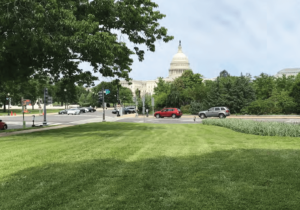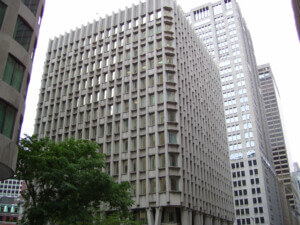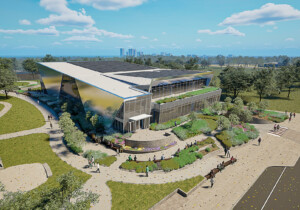The design of today’s public schools tends toward the underwhelming. Their formal and material solutions tell a story of frugality of means as well as of imagination. Even in those instances where the architecture does excel, where it manages to bond function with uplift, the effect is always hampered by a menacing apparatus of security devices and barriers.
It wasn’t always so. In 1960s Washington, D.C., Black architects drew on the prevailing Brutalist idiom in monumental designs that aimed to match transformational notions of schooling with sculptural massings in raw concrete. In various essays, historian Amber N. Wiley has given close scholarly attention to the design of Shaw Junior High School and Dunbar High School and the social currents that gave rise to them. She plans to extend this research in a forthcoming book tentatively titled Concrete Solutions: Architecture, Activism, and Black Power in the Nation’s Capital. AN’s executive editor, Samuel Medina, caught up with Wiley to discuss this surprising, tragic chapter of D.C. architectural history.
AN: How did you become interested in the history of school design?
Amber Wiley: The short answer is by accident. I went to George Washington University for a PhD in architectural history, after studying architecture at Yale. At GWU, I was in a seminar led by Suleiman Osman where we had to choose a research topic that utilized archives in D.C. I had heard a lot about Dunbar High School. Not only was it the first Black public high school in the nation—it was formed in 1870—it was the first public high school in D.C., period. (That part isn’t well known.) It just had this illustrious history, and I thought, “Maybe I’ll do my research on Dunbar.” Now, I’m from Oklahoma City, but D.C. is my second home—my mom was born and raised in D.C.—and I had never been to Dunbar. I pulled it up on Google Maps and saw that it was around the corner from my grandpa’s house. I drive over there, preparing myself to walk down the hallowed halls of this school, ready to soak up all this history. But when I get there, I thought I entered the wrong address. Standing in front of me was this high-rise windowless Brutalist building. It didn’t jell with the Dunbar I had in my mind.
What did you have in mind?
A regal red-brick school building [Laughs]. I immediately jumped to several conclusions, thinking that there was no way that the community had anything to do with this monstrosity. I started to do my research, and come to find out, the school was part of a community-led effort. I was blown away by how wrong I was. I came across Dunbar and opened up a can of worms.
Based on your research, what would you say made D.C. a place where Brutalist architecture and community activism came together?
Howard University. I looked at the history of Howard’s School of Architecture and found out it had been offering drafting classes in their manual arts department since 1910. You’ve got Black architects who are teaching at the university and also designing its campus. But they’re not getting major commissions outside of Howard. Albert Cassell is the best-known example, but Hilyard Robinson, who comes later, is another.
There’s a notion of professionalization within the architecture field that’s important. It’s how you get architects like Robinson who practice in the popular idiom of their day, and their work shows up in the Howard University School of Architecture brochures and catalogs that I found in the archives. It’s a desire to be accepted by the mainstream. I talked to Melvin Mitchell, an amazing architect who came out of that era—the ’50s and ’60s—and he told me that “[Paul] Rudolph is what we were taught. We loved modernism.” And I’m like, “Yeah, it shows.” [Laughs.] It was their way of trying to prove their mettle, right? “We can play with the big boys too.” They weren’t about designing for communities in new paradigms. After ’68 there was a major shift in the studio culture at Howard, but the folks who were getting the commissions were still the older generation that was really tied to heroic modernism and innocence.
Where do the architects of Dunbar High School fit in this generational split?
The school was designed by Bryant & Bryant, a Black-owned firm run by two brothers trained at Howard. The commission—for the newer, Brutalist school that replaced the 1916 Dunbar High School I was expecting to see—was a breakthrough for them. They were part of a generation of architects that got their gigs only after ’68 and home rule [when Congress afforded D.C. limited self-rule through mayoral and city council elections]. Charles Cassell, of the esteemed Cassell architecture family [he was Albert’s son], was on the first elected school board in the District of Columbia. And he ran for that position so that he could advocate for Black architects getting these big design commissions. Not just Dunbar but also Shaw Junior High School and a lot of elementary schools. That blew my mind: “Whoa, an architect was on D.C.’s first school board?” That means something to me.
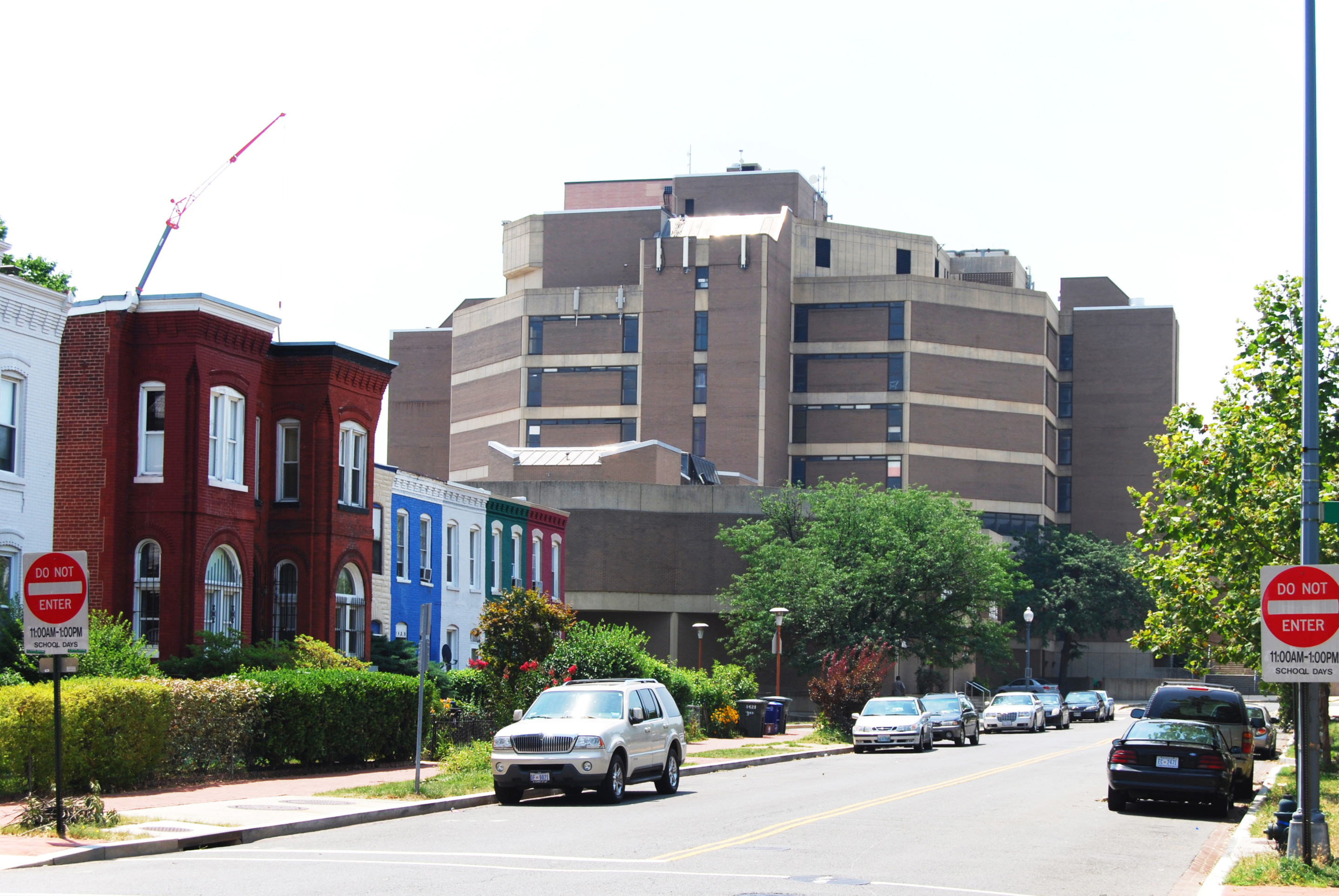
Educational reform began taking shape in the ’50s after Brown v. Board of Education ruled against segregation, before picking up in the ’60s and tapering off in the mid-’70s. D.C. was seen as a test site for many reform-based initiatives. What was the state of the city’s schools at that time, prior to these architects’ interventions?
Black schools in D.C., especially from the ’30s through the ’50s, were allowed to be overcrowded and overused. An enormous strain was being put on these older buildings. There were fire hazards, electricity issues, bad egress, outdated electrical systems. Students were attending in different shifts—they couldn’t even get a full school day in. Brown v. Board may have happened in 1954, but even after the passing of the Civil Rights Act in 1964, little progress was made on desegregation. I looked into the Coleman Report, an independent nationwide study mandated by the Civil Rights Act and published in ’66. The report asked if there was an equality of educational opportunities in elementary and middle schools across the U.S.—that was the official title, Equality of Educational Opportunity—and the answer was “No, there is not.” According to the findings, many school systems were basically resegregated if they were ever desegregated in the first place. Obviously, the worst schools were in the South, but Washington schools weren’t much better. That fact was embarrassing for policymakers in the time of the Great Society. D.C. was supposed to be the symbol of good progress.
Then the next year the Passow Report came out, which looked specifically at the state of the school system in the District of Columbia. It said that the schools were ancient relics. Julius Hobson [an activist city councilman] had sued the school system for discriminating against Black students by putting them on academic tracks. If you were put onto a track, you usually stayed on that track for the entirety of your education in D.C. public schools. For Black students, there was very little opportunity to move up to the honors track, and for white students, it was unlikely for them to [be dislodged] from an honors track. The Passow Report finds that this system was abused and was abusive. When it came to looking at educational facilities, it finds that they were dingy and dark. [The report’s authors] audit classes in classrooms where there are rats and plaster is falling off the wall. It was highly embarrassing to the superintendent, Carl F. Hansen, who eventually loses his job. Julius Hobson wins his suit against the track system. But this is 12 years after Brown v. Board. Twelve years that D.C. schools were pigeonholing students, sending them to the crappiest schools. The Passow Report basically said, “This can’t stand any longer.” It was all ammunition for the kinds of projects that happened in the late ’60s and early ’70s.
We’re nearing the pivotal year of 1968. You write poignantly how, in 1967, Martin Luther King Jr. gave a speech at Cardozo High School near Howard University in favor of urban renewal. This would seem to complicate popular perceptions about both urban renewal and MLK, no?
As I did my research, I kept getting shocked by the things I found. Shocked about who designed Dunbar, and shocked that Martin Luther King Jr. spoke at a D.C. public school on behalf of urban renewal in a predominantly Black neighborhood. But he spoke at the behest of Walter Fauntroy, who was a fellow reverend and member of the Southern Christian Leadership Conference. He was also D.C. born and bred, a Dunbar grad whose church was in the Shaw neighborhood. I found evidence of Black pastors in Shaw who were afraid of losing their congregations if the major kind of demolition associated with urban renewal were to happen. They were saying, “It’s happened before. We lost congregations in Georgetown. We lost congregations in Southwest. They’re coming for us next.” It was a bubbling up of clergy activism. And because Fauntroy was pivotal in organizing the March on Washington in ’63, he was very close to Martin Luther King. The event started at Dunbar and concluded with King’s speech at Cardozo. This was a year before King was assassinated.
And when he is at his most radical, a side of King we hear too little about.
Exactly. There’s going to be some juicy quotes in the book where he says, “We can’t end the slums without taking the profit out of the slums.” So [after the success of civil rights in the South] he takes his fight to the North. He goes to Chicago to fight for fair housing and gets stoned. What he’s trying to do is battle for Black folks in urban areas that have been disinvested. Urban renewal is one way to change that. At Cardozo he’s saying, “You know what? You can actually make this work for you if you listen to my good friend Walter Fauntroy. He’s got some great ideas for ways that we can control [urban renewal] for our benefit.”
What’s the connection between Fauntroy and urban renewal?
He was getting his divinity degree at Yale when New Haven was supposedly leading this new kind of urban renewal, one with community participation. Later, when he is in Shaw, he thinks, “I can bring this to my neighborhood, and I can also keep it from displacing my congregation.” But he was having a hard time convincing Shaw residents that urban renewal was for them. Shaw had a junior high school that was put on a list in the 1940s to be replaced by new facilities. But the 1950s came and went. No new Shaw. The first half of the 1960s came and went. Still no new Shaw. So Fauntroy said, “We can make a new school building a key part of our urban renewal plan,” which becomes the Shaw School Urban Renewal Area. Fauntroy creates his Model Inner City Community Organization, giving members of the Shaw community a role in the decision-making process. There’s now federal funding coming in and community groups directing it. Black architects and planners get very involved. Then the ’68 uprising happens, which leaves a lot of destruction in Shaw, and there is an imperative to build and to involve Black architects, who demand to be involved. That’s when the commission of Shaw Junior High School goes to a Black architecture firm, Sulton-Campbell Architects.
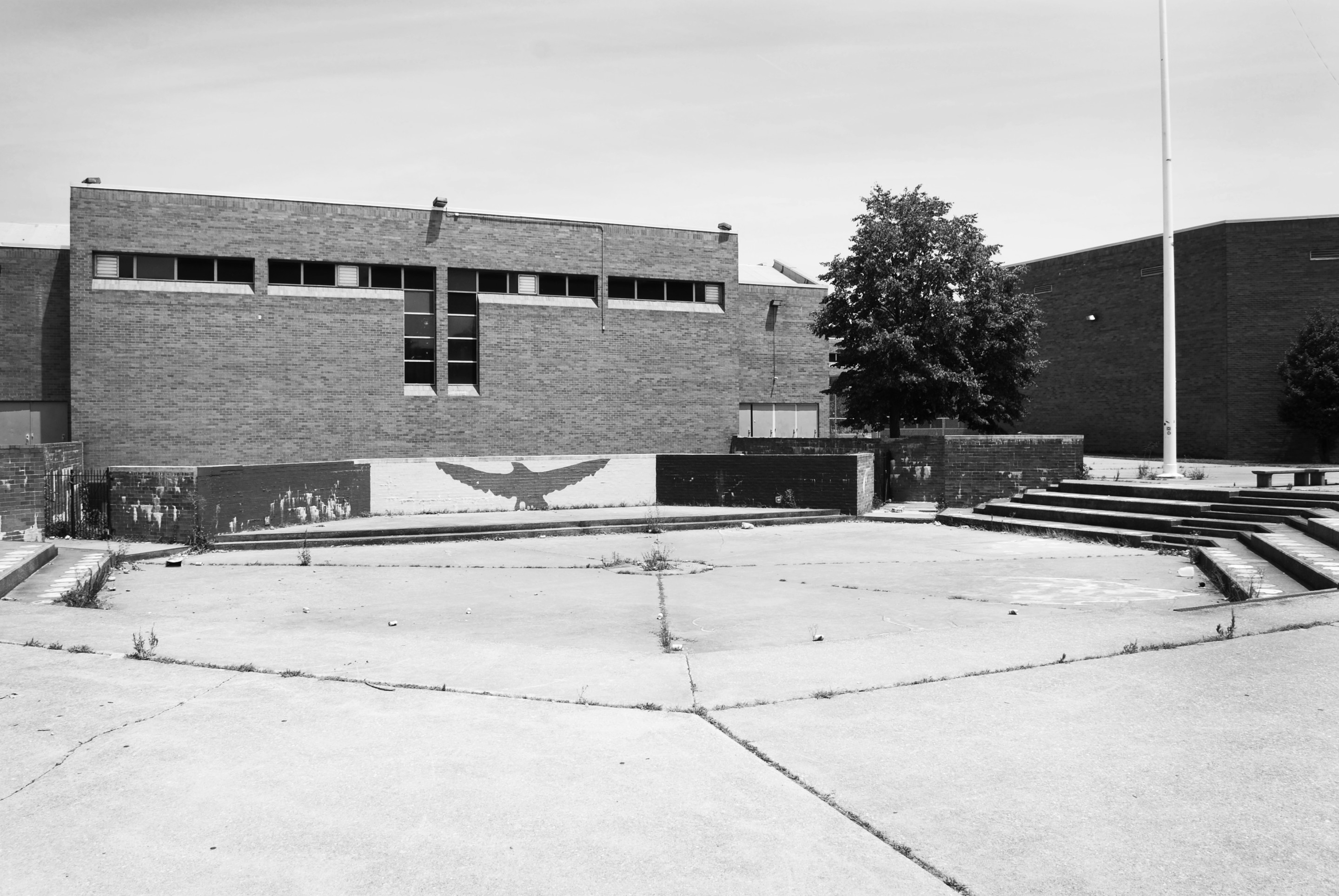
You’ve described that the school-as-built is close to an “education park,” a planning idea that was popular at the time. Another was the idea of open space planning within the school buildings themselves. How were these ideas implemented at Shaw and Dunbar, and were they successful?
This open-plan model really seemed [to school reformers and community leaders] the way of the future. The rhetoric was all about knocking down walls between students and teachers, knocking down barriers and the rigidity of school curriculums. In the older school buildings in D.C., teachers stood at lecterns and students sat behind rows of desks nailed to the floor to keep them from moving around. But also, the track system was really hated for a different kind of rigidity. People considered Superintendent Hansen as being authoritarian because the system ultimately re-created a sort of caste system. So on a conceptual level, demolishing the track system and creating an equal playing field was really appealing.
This rhetoric played out in the spatial sphere, of course. These schools weren’t going to have columns or corridors. Instead, the Shaw and Dunbar school buildings were very big—Shaw was designed for 1,200 students and Dunbar 1,800—and divided into subschools with their own facilities. The funny thing is, open-plan schools had originated in Great Britain and were really meant for young kids and Montessori-style teaching, where you’re rotating [students] in and out. There is no collective learning. The idea was never really meant to be applied to middle and high schools [as it was in D.C.]. And a lot of teachers didn’t know what to make of these open layouts that promoted team-based teaching. Maybe they feared losing control of their classrooms. What ends up happening is they start using bookcases to form barriers between, for example, the English class and the math class. They want to set off their own space from the larger open plan.
The Black architects who designed Shaw, who designed Dunbar, are very much influenced by a lot of the educational rhetoric coming over from Great Britain, on a conceptual level but also more on an aesthetic level. I think of Dunbar, or Shaw, less as one school and more like four or five open-plan schools. Both were very tough on the exterior, but inside, the spaces were meant to be flowing and communal, with lots of [top] light. Communal on the inside and monumental on the outside.
Initially, these school buildings were very well received by their communities. What changed?
People loved these schools when they opened. They had all sorts of technology that was brand-new for the ’70s. The Brutalist Dunbar building was the most expensive school to be built in D.C. at that time! The architects were just really imaginative about the relationship of learning spaces to each other. One of my favorite features of the Dunbar school was the cafeteria. It was really high up with windows all around. Imagine you’re a student and eating your lunch up there. From your table you can see the Capitol Building to the south and, to the north, Howard University’s Founders Library.
As part of my research I started to have these conversations with people in the community, mostly in their mid-20s. This was 2008/2009, when the 1977 Dunbar school was set to be replaced by a new one [designed by Moody Nolan].
The people I was speaking to just rejected the notion that there was any benefit to looking at that design and the ideas [it held]. They were vehemently opposed to that older building. But I think part of that really passionate opposition really comes from the fact that the school was in horrible condition. Budget cuts rendered aspects of these designs useless. And there were huge issues with maintenance. There was graffiti. Mess was everywhere. I’m not sure the carpet was replaced once in 30 years. It was just extremely unlovable.
You mentioned teachers and administrators fearing losing control over their students and classrooms. As you’ve written, control over shaping behavior, and policing that behavior, has always been a core function of schooling. How was this applied at these architectural case studies?
So the idea with the communal spaces at Dunbar was that [administrators] could monitor and see students. It was about what I call “passive” surveillance, where the students are being observed in a panopticon—think of Michel Foucault—but they don’t really feel it. But there’s also this tension between this exciting open environment and this surveillance and also the presence of police officers, which is already happening in D.C. public schools in the early ’70s. Charles Cassell talks about this on the D.C. school board, questioning why there were armed policemen in these schools and what their role was. At the new Dunbar school that opened in 2013 [replacing its Brutalist predecessor] there are metal detectors and CCTV video cameras recording the students at all times. They know they are being watched. I don’t want to suggest that passive surveillance is better than this active surveillance. But what I do want to point out is that after 50 years, we’re still having this debate.







